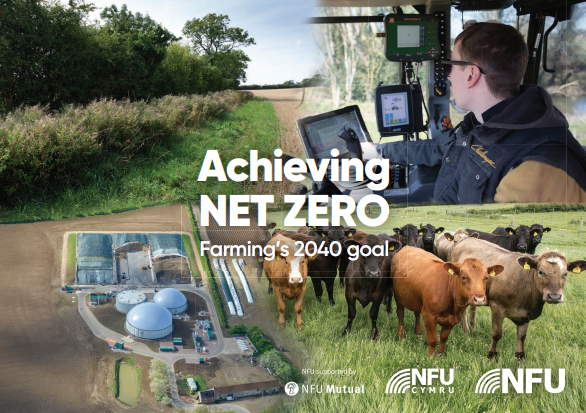The National Farmers’ Union of England and Wales (NFU) have stated in their report of a possible way of achieving net zero for greenhouse gas emissions through agriculture.
 The National Farmers' Union of England and Wales (NFU) have stated in their report of a possible way of achieving net zero for greenhouse gas emissions through agriculture. UK farms' annual greenhouse gas (GHG) emissions currently amount to 10% of the UK's GHG emissions. They have identified farms as a form of capturing the carbon in the air and transforming it into a wide range of foods. They have looked at three activities that will help the industry reach its goals of achieving net zero in agriculture by 2040: improving the productive efficiency of farms; improving the land management to capture more carbon; and boosting renewable energy.
The National Farmers' Union of England and Wales (NFU) have stated in their report of a possible way of achieving net zero for greenhouse gas emissions through agriculture. UK farms' annual greenhouse gas (GHG) emissions currently amount to 10% of the UK's GHG emissions. They have identified farms as a form of capturing the carbon in the air and transforming it into a wide range of foods. They have looked at three activities that will help the industry reach its goals of achieving net zero in agriculture by 2040: improving the productive efficiency of farms; improving the land management to capture more carbon; and boosting renewable energy.
Agricultural GHG emissions are very different from other sectors of the economy, such as electricity generation, transport and manufacturing. The principal GHG emitted by most industries is carbon dioxide (CO2) from fossil fuel combustion, while for agricultural systems methane (CH4) and nitrous oxide (N2O) are the main GHGs. Reducing these emissions is more difficult than cutting CO2, because they result from complex and imperfectly understood natural soil and animal microbial processes, a changing climate and the limitations of measurement.
A supply of nitrogen from organic or inorganic sources is necessary for the growth of crops and pasture, and it is an unavoidable consequence of soil processes that a small amount of nitrogen in an agricultural system will be emitted as nitrous oxide. Likewise, methane is produced by bacteria as cattle and sheep break down the cellulose in their diet, producing milk and meat for human consumption from large areas of grassland that would be unsuitable for arable farming.
The current UK agricultural GHG inventory British agricultural GHG emissions in 2017 were 45.6 million tonnes of CO2 equivalent (10% of UK total GHG emissions), comprising methane (5.6% of UK total), nitrous oxide (3.1%) and CO2 (1.2%). Agricultural emissions have decreased by 16% overall since 1990, but there has been only modest progress since 2011, when the industry’s GHG Action Plan was agreed.
End of Preview
